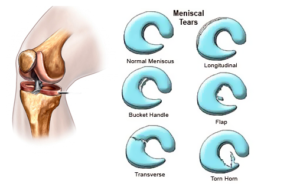The amount of recovery time for meniscus tear surgery varies depending on the severity of your injury. It also depends on what surgery was done and your orthopaedic surgeon’s preference.
Generally, the aftercare and rehabilitation includes rest and then walking and specific exercises.
Before you continue reading, keep in mind that the numbers we show you are average statistics and that every recovery is different. Getting back on your feet requires many things.
Typical times for returning from meniscus surgery.
| Progress | Uncomplicated Meniscus Removal or Meniscectomy | Meniscus Repair Surgery |
| Bear some weight put weight on your knee | Right after the surgery, if you can tolerate it. | After the surgery, with the help of a brace. |
| Walk with no crutches | 2-7 Days | 4-6 weeks |
| Drive | 1-2 weeks, if:
|
4-6 weeks |
| Full movement capacity | 1-2 weeks | Bending is usually restricted to under 90 degrees for the first 4-6 weeks while the meniscus is still healing. |
| Come back to athletic activity | 4-6 weeks, if:
|
3-6 months |
What do I need to know about meniscus tear and how to fix it?
 The meniscus is an internal part of the knee. It is a c-shaped piece of rubbery but tough cartilage.
The meniscus is an internal part of the knee. It is a c-shaped piece of rubbery but tough cartilage.
The meniscus is a vital part of your body as it acts as a shock absorber between the shinbone and thighbone.
How does a meniscus get torn?
If you suddenly twist the knee while you are bearing weight on it, the meniscus can be torn. This condition is one of the most occurring knee injuries, especially for athletes.
What happens when you have a torn meniscus?
Torn knee cartilage usually happens to athletes because they do much physical activity strenuous to the knees. As a result, patients typically feel pain in the region where the tear is and experience swelling in the knee joint.
The pain and swelling become worse when the patient does pivot motions, squats, and vigorous activities usually done in sports.
When torn meniscus fragments get caught in the knee joint, the result is noticing sensations. And, when a large enough piece gets lodged between them, the knee can lock, and the patient will be unable to bend or extend the leg fully.
To fix this issue, an athlete must undergo meniscus repair or else the condition might worsen and cause long-term to permanent consequences.
What are the symptoms?
Symptoms for a torn meniscus include the following.
- Feeling a popping sensation.
- Experiencing swelling or stiffness.
- Pain in the knees that worsen when you twist or rotate it.
- Inability to quickly straighten the leg.
- Feeling like the knee is locked in place as you try moving.
- Feeling as if the knee is giving way.
How is a torn meniscus treated?
The arthroscopic meniscus repair is a procedure done to repair torn knee cartilage, usually for athletes. The torn meniscus is corrected via a minimally invasive procedure depending on the kind of injury.
The aftercare and recovery require postoperative protection to allow healing. Recovery is helped by physical therapy, which is done for the patient to regain the full function of the knee.
Recovery time for meniscus tear surgery can go anywhere from 3-6 months after surgery.
There are multiple types of procedures, including meniscus removal or meniscectomy, meniscus repair surgery or, in rare cases, meniscus replacement.
What are the different procedures for a torn meniscus?
The goal of meniscus repair surgery is to preserve the meniscus, and it is the go-to procedure when the tear is repairable. However, when it is irreparable, a meniscectomy is done, which is to remove the damaged tissue.
Meniscectomy gives the patient excellent short term results. However, it risks the patient developing arthritis in as little as ten to twenty years in the future.
Meniscus repair surgery leaves the patient with excellent results. However, it takes longer for an athlete to recover.
Additionally, repair requires that the meniscus is not completely damaged and can still be fixed.
For young and active patients who had previously undergone meniscus removal, a replacement procedure is advised when specific parameters are met. Meniscus replacement is considered an option for those who had developed pain in the knee but have no advanced degeneration to the articular or gliding cartilage or gliding surface.
Is meniscus repair surgery effective?
When meniscus repair surgery is done by an experienced orthopaedic surgeon, there is a significantly high percentage of successful recovery. A whopping 90% of patients recover entirely and go back to normal.
Usually, when a person has injured the knee, there is a higher likelihood of suffering arthritis in the future. However, when it is successfully repaired, developing arthritis slows down significantly.
What are the benefits of surgery?
The meniscus is a vital part of the body that is central for shock absorption and load transmission in the knees. Your knees are a crucial body part subjected to up to 5 times your body weight whenever you are active.
50% of the force taken by a straight knee is transmitted to the meniscus. In addition, 85% of the force is taken by it with a 90-degree bent knee.
When you lose part of your meniscus, the pressure on your articular or gliding cartilage increases significantly, and this causes degeneration.
When you undergo meniscus repair surgery, you preserve the tissue and avoid problems such as mentioned.
Recovering from surgical meniscus repair takes longer than a meniscectomy. However, any repairable meniscus should be restored rather than removed.
How do I know that I am fit for meniscus repair surgery?
An athlete should consider meniscus repair surgery when the person is healthy and wishes to remain active in the sport. Also, it should only be done when the patient understands rehabilitation and surgery and all the risks included.
A repair can also be done only if the meniscus tear is in the periphery of the meniscus and if the tissue’s quality is excellent and repairable.
Most importantly, you have to be sure that the surgeon is experienced in meniscus repair. It would be best if you sought quality over lower prices as erratic operations can cost you more money and your knees.
What should I do if I feel like there’s something wrong with my knees?
If you are an athlete and is regularly subject to high physical activity and are feeling suspicious of how your knees are feeling, you need to call a doctor asap.
If you wait too long, you might worsen an injury and need more complex and expensive solutions. So get a check-up and your doctor.
The doctor can identify whether you have a meniscus tear during a physical exam. The practitioner will move your knee and leg into different articulations, observe how you walk and squat to pinpoint what causes your signs and symptoms.
Getting a Second Opinion
A second opinion should be considered when deciding on a high-risk procedure like surgery or you want another opinion on your treatment options. It will also provide you with peace of mind. Multiple studies make a case for getting additional medical opinions.
In 2017, a Mayo Clinic study showed that 21% of patients who sought a second opinion left with a completely new diagnosis, and 66% were deemed partly correct, but refined or redefined by the second doctor.
You can ask your primary care doctor for another doctor to consider for a second opinion or ask your family and friends for suggestions. Another option is to use a Telemedicine Second Opinion service from a local health center or a Virtual Care Service.
Get a Virtual Sports Specialized appointment within 5 minutes for $29
 When you have questions like: How bad is my injury? Should I go to urgent care or the hospital? How long will it be before I can get a doctors appointment? Who can I talk to right now? SportsMD Virtual Urgent Care is available by phone or video anytime, anywhere 24/7/365 and appointments within 5 minutes.. Learn more via SportsMD’s Virtual Urgnt Cae Service.
When you have questions like: How bad is my injury? Should I go to urgent care or the hospital? How long will it be before I can get a doctors appointment? Who can I talk to right now? SportsMD Virtual Urgent Care is available by phone or video anytime, anywhere 24/7/365 and appointments within 5 minutes.. Learn more via SportsMD’s Virtual Urgnt Cae Service.
FAQs
Question: How long does it take to walk after meniscus surgery?
Answer: Immediately after surgery the patient should be able to bear weight on the knee while standing or walking. Crutches or a walker will be necessary for at least 2-7 days after surgery but the doctor we will likely encourage you to stop using them as soon as possible.
Question: How long do you have to stay off your knee after meniscus surgery?
Answer: How long you stay off your knee is dependent on the type of surgery you have. Complicated arthroscopic repair of a meniscus tear requires that the patient’s knee be completely immobilized for 2 weeks after surgery. With arthroscopic meniscus repair or Removal or Meniscectomy the patient can bear weight on the knee immediately after surgery.
Question: How long does it take to drive after meniscus surgery?
Answer: You may drive after meniscus tear surgery when you are no longer on pain mediciations and you are no longer using crutches or a knee brace. You must also have complete control of the functions of your knee before your drive. On average you can drive 1 to 5 weeks after your surgery.
Question: How long after meniscus tear surgery can I go back to work?
Answer: In most cases, if you have a desk job, you can return to work 7-14 days after the operation. For those patiens who have a job that involves manual labor or being on your feet most of the day, your return to work can take 4-6 weeks.
Hot off the press! An update on #meniscus surgery by @DrKrych on the Mayo Clinic Orthopedic Surgery podcast. A rapidly evolving field, with high yield review by one of the best! @MayoClinic @MayoOrthoRes @mayoclinicsport Link: https://t.co/fSqlUCqRHs
— Dr. Jonathan Barlow (@JonBarlowMD) January 14, 2021
The best thing you can do is prevent.
Prevent having a torn meniscus by regularly performing leg exercises for strengthening. Leg exercises will improve the stabilisation of your knee joint and, in effect, protect it from injury.
It would also be best if you use protective gear during sports. You can also use a brace to support your knee during strenuous activities.
If you or anyone you know is an athlete or into sports, we offer a rich resource where you can learn about sports injuries. Knowing about what might happen can help you avoid or mitigate problems to save your money, self and loved ones.
